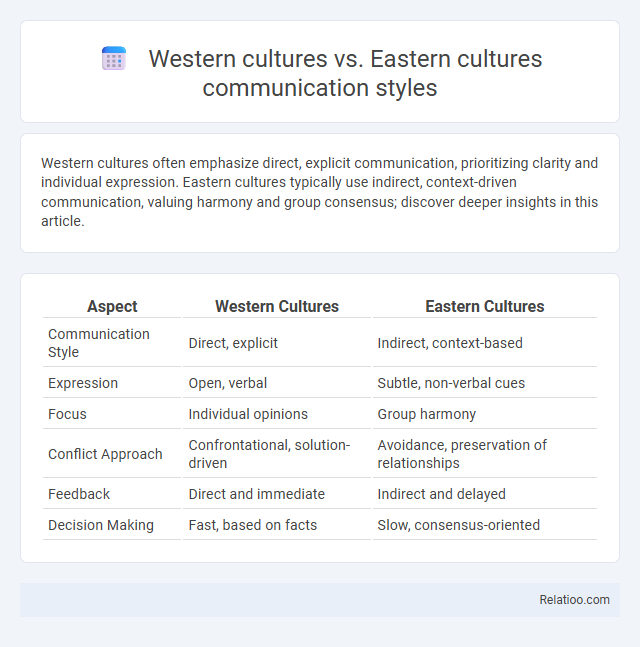Western cultures often emphasize direct, explicit communication, prioritizing clarity and individual expression. Eastern cultures typically use indirect, context-driven communication, valuing harmony and group consensus; discover deeper insights in this article.
Table of Comparison
| Aspect | Western Cultures | Eastern Cultures |
|---|---|---|
| Communication Style | Direct, explicit | Indirect, context-based |
| Expression | Open, verbal | Subtle, non-verbal cues |
| Focus | Individual opinions | Group harmony |
| Conflict Approach | Confrontational, solution-driven | Avoidance, preservation of relationships |
| Feedback | Direct and immediate | Indirect and delayed |
| Decision Making | Fast, based on facts | Slow, consensus-oriented |
Introduction to Western and Eastern Communication Styles
Western communication styles emphasize directness, clarity, and explicit expression of thoughts, reflecting individualistic cultural values. Eastern communication often prioritizes indirectness, harmony, and context, valuing group cohesion and non-verbal cues. Understanding Your role in these contrasting communication approaches can enhance cross-cultural interactions and reduce misunderstandings.
Historical Roots of Communication in East and West
Western communication styles emphasize directness and clarity, rooted in ancient Greek and Roman traditions valuing debate and individual expression. Eastern communication prioritizes harmony and indirectness, influenced by Confucian principles and collectivist social structures emphasizing context and relationship preservation. Understanding these historical roots helps you navigate cross-cultural interactions effectively by recognizing the different priorities and approaches to communication.
Directness vs. Indirectness in Communication
Western cultures often emphasize direct communication, valuing clarity and explicitness to convey ideas efficiently, while Eastern cultures tend to prefer indirect communication, using context and non-verbal cues to maintain harmony and avoid confrontation. Directness in Western communication highlights straightforward expressions and precise language, contrasting with Eastern indirectness that employs ambiguity and subtlety to preserve relationships and face. Understanding these differences is crucial for effective intercultural communication, as misinterpretations may arise from contrasting expectations about openness and politeness in discourse.
Individualism and Collectivism in Conversational Norms
Western cultures typically exhibit direct communication styles emphasizing individualism, where expressing personal opinions and clarity are prioritized in conversational norms. Eastern cultures generally favor indirect communication, reflecting collectivism by valuing harmony, context, and group consensus over explicit statements. These contrasting approaches highlight how cultural frameworks shape the interpretation and delivery of messages within social interactions.
Role of Nonverbal Cues in Western and Eastern Cultures
Nonverbal cues play a crucial role in both Western and Eastern cultures but differ significantly in their use and interpretation. Western communication often emphasizes explicit verbal messages supported by direct eye contact and expressive gestures, reflecting individualism and clarity. In contrast, Eastern cultures rely heavily on subtle nonverbal signals such as tone of voice, silence, and restrained facial expressions to convey respect, harmony, and context.
Attitudes Toward Silence and Verbal Expression
Western cultures often prioritize direct communication with an emphasis on verbal expression, valuing clarity and explicitness in conversations. In contrast, Eastern cultures tend to view silence as a meaningful and respectful component of communication, reflecting thoughtfulness and harmony rather than discomfort. Understanding these differences in attitudes toward silence and verbal expression helps you navigate cross-cultural interactions more effectively.
Hierarchy and Respect in Communication Approaches
Western cultures often emphasize direct communication styles that prioritize clarity and individual expression, with less focus on hierarchical status in everyday interactions. Eastern cultures typically adopt indirect communication approaches that emphasize respect, harmony, and maintaining social hierarchy, valuing context and relationships over explicit verbal exchanges. Understanding these distinctions reveals how hierarchy shapes communication, influencing the degree of formality and deference present in different cultural interactions.
Conflict Resolution Styles Across Cultures
Western cultures often favor direct communication styles in conflict resolution, emphasizing transparency and explicit expression of thoughts to quickly address issues. Eastern cultures typically adopt indirect communication, valuing harmony and subtlety to avoid confrontation and preserve relationships. Understanding these differences can enhance Your ability to navigate cross-cultural conflicts effectively.
The Impact of Globalization on Communication Practices
Globalization has significantly influenced communication styles, blending Western cultures' emphasis on direct, explicit messages with Eastern cultures' preference for indirect, context-sensitive communication. The increased intercultural interactions require adapting communication strategies to balance clarity and politeness, ensuring effective understanding across diverse cultural contexts. Technology and global business demand heightened cultural awareness, driving shifts toward more flexible communication practices worldwide.
Strategies for Effective Cross-Cultural Communication
Western cultures typically emphasize direct communication, valuing clarity and explicit expression, while Eastern cultures often prioritize indirect communication, relying on context and nonverbal cues to convey meaning. Effective cross-cultural communication strategies include active listening, cultural empathy, and adapting communication styles to bridge differences, such as simplifying language and confirming understanding. Utilizing these approaches enhances mutual respect and reduces misunderstandings in diverse intercultural interactions.

Infographic: Western cultures vs Eastern cultures communication styles
 relatioo.com
relatioo.com